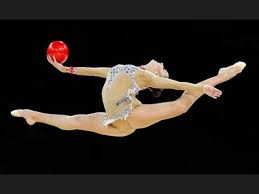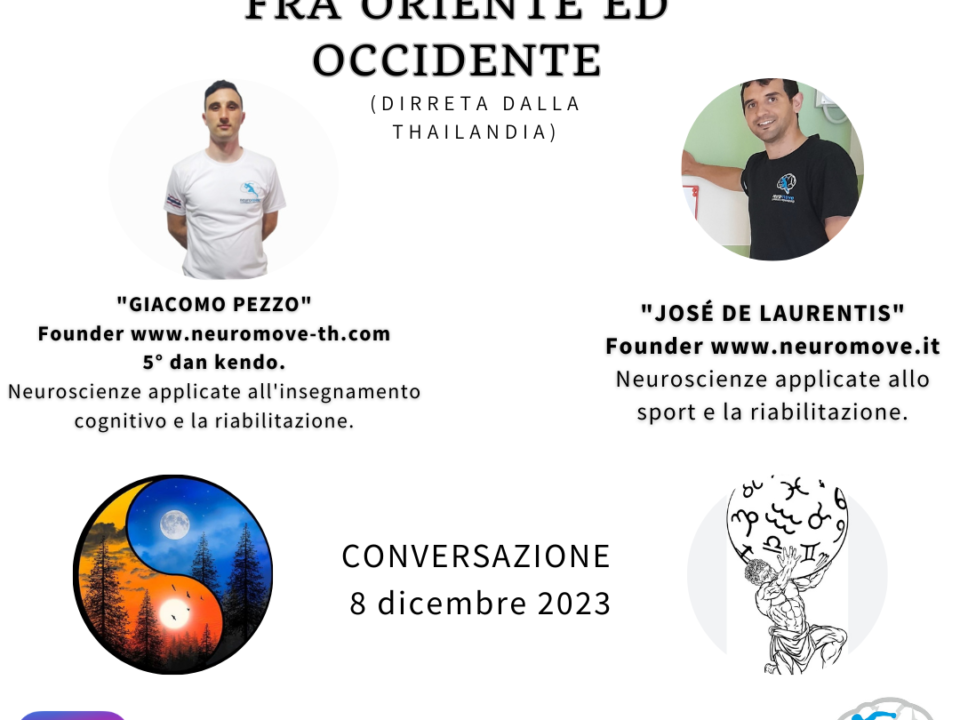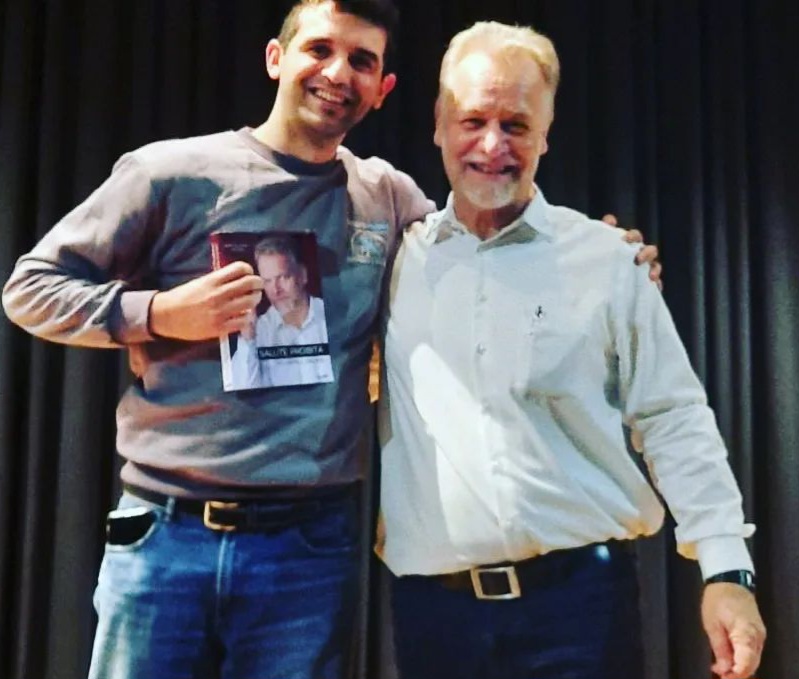- Motion Realizing
- info@neuromove.it
GENI, and LATERALIZATION FLEXIBILITY IN RHYTHMIC GYMNASTICS

Introduction
The world neuromotor starts from genetics of our species.
L’intera storia della neurologia e della neuropsicologia può essere vista come la storia delle indagini sull’emisfero sinistro. Una ragione importante di questa relativa indifferenza per l’emisfero destro o «minore», come è sempre chiamato, è che mentre gli effetti di lesioni variamente localizzate nella parte sinistra sono facilmente dimostrabili, le corrispondenti sindromi dell’emisfero destro appaiono molto meno chiare. Tale emisfero era di solito considerato sprezzantemente più «primitivo» del sinistro, che era visto invece come l’esito ineguagliato dell’evoluzione umana. E in un certo senso è così: l’emisfero sinistro è più complesso e specializzato, è un prodotto molto tardo nello sviluppo del cervello del primate, e in particolare dell’ominide. D’altro lato, è l’emisfero destro che è preposto alla cruciale funzione del riconoscimento della realtà, capacità che ogni creatura umana deve avere per sopravvivere.
The left hemisphere, such as a computer connected to the basic human brain, need to develop programs and schemes; and classical neurology was more concerned that the schemes of reality so that when he finally emerged some aspects of the right hemisphere, they were considered bizarre.
The Nobel laureate Roger Sperry of Caltech formulated the theory of the two brains, the left is the brain of the numbers, the logic, the processing of information. While the right is the imagination, emotions and consciousness of space.
Today neuroscience, allow us to think that the hemispheres work and associate so much more complex than the simple idea of a split brain.
Paul Dorochenko sostiene che, attraverso la sua esperienza nel circuito di tennis, un numero pari all’80% dei giocatori è contraddistinto dagli aspetti dell’emisfero sinistro. Coloro sono più concentrati sui dettagli, sono più razionali, vogliono sapere il perché, quando, come, sono tattici, e si concentrano nel tempo; spesso sono inibiti per la pressione. Coloro che, invece, sono contraddistinti dagli aspetti dell’emisfero destro, sono abili nella spazialità, creativi, poco concentrati ma bravi nelle azioni, più eccitati che inibiti dalla pressione. “É chiaro che non siamo uno o l’altro, ma nonostante le varianti di ogni uno può chiarire un profilo generale”.
Per le interpretazioni delle ricerche nella nostra epoca Paleolitica, l’uomo ha avuto una forte influenza nel lato destro del corpo. Le impronte digitali e gli strumenti dei nostri antenati mostrano chiaramente che l’uomo era quasi interamente destro. Dal fatto che un emisfero cerebrale domina la parte controlaterale del corpo, sarebbe molto ragionevole pensare che il motivo per cui più di 80 % della popolazione è destra sia di mano che di piede, viene collegato dall’esito evolutivo dell’emisfero umano più evoluto; questo ha permesso (lavorando integralmente con il cervello destro) calcolare, elaborare informazioni, guidare numeri, in altre parole adattarsi e sopravvivere. Dunque, la selezione naturale ha mantenuto le funzioni dell’emisfero sinistro attraverso il tempo, e ha permesso la preferenza “dell’emicorpo destro” nei movimenti che di solito facciamo.
Antonio Damasio says that the hemispheric lateralization exists because it must only be a final controller not two, this allows an alternation and a better balance kinetic in our species, thus avoiding movements clumsy and imprecise.
D’altra parte, l’uso preferenziale all’inizio del movimento è automatico, inconscio, procede a favore della regola di base in nostra neurofisiologia: “Fare economia di energia” secondo Leopold Busquet. In altre parole, se la nostra neurofisiologia non funzionasse in questo modo, saremmo in grado di lavarci i denti con la mano sinistra un giorno, o scrivere con la mano destra e sinistra efficientemente. Inoltre, nel tennis, saremmo in grado di effettuare un servizio a destra e uno a sinistra, o alternare inconsciamente la spaccata antero-posteriore nella ginnastica ritmica senza problemi, né dolori, ed eseguire elegantemente entrambi i gesti tecnici.
Sport and Laterality
Dorochenko distinguished by laterality lateralization, stating that lateralization is the process through which the child gets to make a preferential use of a body part, right or left, while the laterality is defined as the supremacy of one cerebral hemisphere on other things, that allow later the preference of hemi-body relative to each other.
In lateralization affect the social and cultural aspects of each country; or popular sports disciplines, sports culture of the family, learning and motor learning, training of professionals in the study of human movement.
The laterality is influenced by genetic history dell'homosapiens. Brain Dominant, imitation and mirror neurons, for example.
Eye Director or Dominant:
Only 30% of the population has left the dominant eye. The socio-cultural influences on the ocular system does not exist in comparison with those of the hand, the eye is practically a part of the brain.
The Eye director has a dominant relationship with the opposite hemisphere. There are psychological tests that claim that brain dominance (Benziger test) has a higher correlation of 80% in determining the dominant hemisphere.
Clarification A: Psychological tests reflect the processing mode of the information, depending on the functionality of each hemisphere, and not the preferential use in the field of the other hemi-body movement.
Statement B: the most important aspects are the integration we do as organizations. Cerebral hemispheres, and half-bodies left and right, respectively, cooperate and work together in an economic and efficient manner.
The Eye director tells us what is the dominant hemisphere, ie “the opposite”. Secondly, tells us in correlation, mental dominances corresponding to each hemisphere. The eye of the director would have a main role in the first focusing on the ball (tennis, baseball, etc.).
Laterality of hands:
It is common to be left to write, draw, and right for basketball or tennis. The man in the story is usually always right, only 13% left. The scientists at Northwestern University have suggested that left-handers are few because of the balance between cooperation and competition. The cooperation calls for a joint use use the same tools. We can not forget the non-dominant hand, important in many sports; point the ball in the court, give the direction of the shooting basketball, and baseball, and so on.
Laterality of the shoulders and pelvis:
We have a preferential direction with respect to the rotation of the shoulder girdle, such as pelvic.
He who turns from right to left is right behind, left to right, however, it is left-handed.
Dynamic Leg: 80%:
This explains why in the athletics stadium, making the race counterclockwise: men, dogs, horses have the right dynamic leg.
Dominant foot:
We must be very cautious in the association, dynamic leg and dominant foot. One can also find a dynamic right leg and a left dominant foot, or the opposite.
Research Methodology:
Tests were carried out neuro-motors 70 gymnasts aged between 13 and 25 years.
1-Occhio direttore. 2-Gamba dinamica. 3-Piede dominante. 4-Gamba che fa il primo appoggio nella ruota. 5-Gamba che fa la flessione dell’anca nella tecnica di spaccata antero-posteriore. 6-Ischiocrurali meno flessibili.
Conclusion:
Questa ricerca sostiene che la flessibilità (secondo di Mario Di Santo), ovvero la capacità psicomotoria, e le proprietà responsabili della riduzione e minimizzazione di tutti tipi di resistenza che le strutture e i meccanismi funzionali neuro-mio-articolari di fissazione e stabilizzazione offrono nell’esecuzione di movimenti di ampiezza angolare ottima prodotta, si sviluppi sia per l’azione di agenti endogeni (contrazione del gruppo muscolare agonista) sia per quelli esogeni (proprio corpo, compagno, sovraccarico, inerzia, altri strumenti). Quindi, la flessibilità viene determinata in gran parte (ma non del tutto) dalla genetica della specie, che a sua volta delimita la sinergia nel funzionamento delle catene muscolari tra un emicorpo e altro. Vedi ‘Teoria Denys Struyf’ on the physiological asymmetry.
Concentriamoci sull’articolazione coxofemorale, precisamente sul movimento di estensione e flessione con le ginocchia tese; possiamo dire che nella tecnica di spaccata antero-posteriore della ginnastica ritmica, l’87% dei casi gli ischiocrurali della coscia che deve fare l’estensione (cioè la gamba va indietro) è meno flessibile in confronto alla sua contralaterale . Allo stesso tempo, nella stessa coscia, gli antagonisti degli ischiocrurali, cioè la muscolatura che flette l’anca ed estende il ginocchio, sarebbero più flessibile che la sua contralaterale, ma questa affermazione non è stata verificata con certezza, è solo una deduzione logica; è stato verificato solo il comportamento degli ischiocrurali (muscoli responsabili dell’estensione dell’anca, e della flessione del ginocchio).
Again, in’ 87% of cases our hypothesis has been confirmed, ie the hamstring muscle that performs the extension is less flexible than its contralateral that carries out the bending in the split antero-posterior of the rhythmic gymnastics (13% in only 9 cases analysis data is incompatible with our hypothesis, it is suspected the possibility of cultural influence, or an exception to the rule).
So the evolutionary history of our species has led to a dominant hemisphere in terms of movement. It will automatically choose a dominant eye, which in turn will affect, together with other aspects, the preferential use of hemi-body relative to each other; we talk about “lateralization process”.
This automatic preferential use will be somewhat’ più determinante nel lavoro neuro-motorio di un emicorpo sull’l’altro (si intende in questa ricerca, nei muscoli coinvolti nella flessione ed estensione dell’anca); in altra parole, ogni volta che l’insegnante chiederà di fare una spaccata antero-posteriore, le allieve attiveranno l’emicorpo inconsciamente predisposto dal loro emisfero dominante in materia di movimento neuro-motorio. Questo procedimento sviluppato nel tempo e a lungo andare, costruirà le caratteristiche della capacità neuromuscolari; più flessibilità, più forza esplosiva, un migliore controllo motorio, una migliore propriocezione, a seconda dell’uso di ciascun emicorpo, anche a seconda delle caratteristiche e del tempo di esecuzione del gesto.
We must underline that the split feature of the rhythmic gymnastics can observe in a clearer way, since the amplitude of movement necessary to realize the technical act in harmony helps us to verify the asymmetry in the flexibility of the two also.
In this research, 65% of cases the dominant eye is right, and second Dorochenko 65% would like the left brain dominant.
In 58% of cases the dynamic leg is the right, left and in 22% in 20% ambivalent (there was no preference conscious of a leg relative to each other in the course of the test performed). In 88% of cases the dominant foot is his right, and in 12% the left.
The right leg is the one that moves forward in 75% of cases in the split anterior-posterior, ie one that carries out the hip flexion. Only in 25% of cases it is the left one that moves forward.
Infine, in 51 casi di questa indagine, cioè il 73% del totale della ricerca, la gamba dinamica è la stessa che fa la flessione dell’anca nella spaccata antero-posteriore (gamba che va avanti). Questi dati ci mostrano come la gamba dinamica sia la prima ad agire (eseguendo il movimento naturale della flessione dell’anca nella marcia) in diverse tecniche della ginnastica ritmica; ed è così grazie a meccanismi inconsci e alle loro caratteristiche neurofisiologiche.
Esiste anche una forte correlazione tra gamba dinamica ed un’altra tecnica ben nota: la ruota. La gamba dinamica è quella che prima appoggia all’inizio del movimento della ruota. In 44 casi è la stessa, ma tuttavia questa tecnica è anche determinata dalle lateralizzazione della spalla e dell’anca, perché possiamo osservare come ruotano il tronco e la pelvi durante la sua esecuzione.
We can deduce from this research that our motor skills and neuromuscular capabilities of our two half-bodies, are largely determined by the genetic heritage of our species. As children we adapt to different sports techniques, namely the various structured movements due to innate predispositions in the brain. These predispositions (dominant hemisphere and dominant eye) plus the sum of the lateralization process in sports, build neuromuscular characteristics of our two half-bodies: dynamic leg or skilled, supporting leg, dominant hand – non-dominant, dominant foot – non-dominant, dominant shoulder – non-dominant, dominant Basin – not dominant.
Knowledge of these variables, it helps us in planning the work of the non dominant, intended as “movement”, In the development of motor skills of children, in the functioning of the two hemispheres, in the workload compensation for the stability of the column and in the enhancement and correction of the most commonly used movements in different kinds of sports, for both young people and adults ".
Sources:
Paul dorochenko “The dominant eye ”
Mario Di Santo "of bracket width"
Leopold Busquet “muscle chains”.
Antonio Damasio "The self that comes to mind."
Jose De Laurentis “The effects of Core Training in unstable and stable contexts”.
Denys Struyf “The manual Mezierista”.
Muscle and joint Chains "Concept G.D.S Philippe Campignion”
Oliver Sacks' "The man who mistook his wife for a hat."
Stefano Tamorri “Neuroscience and sports”.
J.Lopez Chicharro.L.M López Mojares “Clinical Physiology year”
Carmelo Pittera “The system PSICOM”
Autore: Jose De Laurentis






